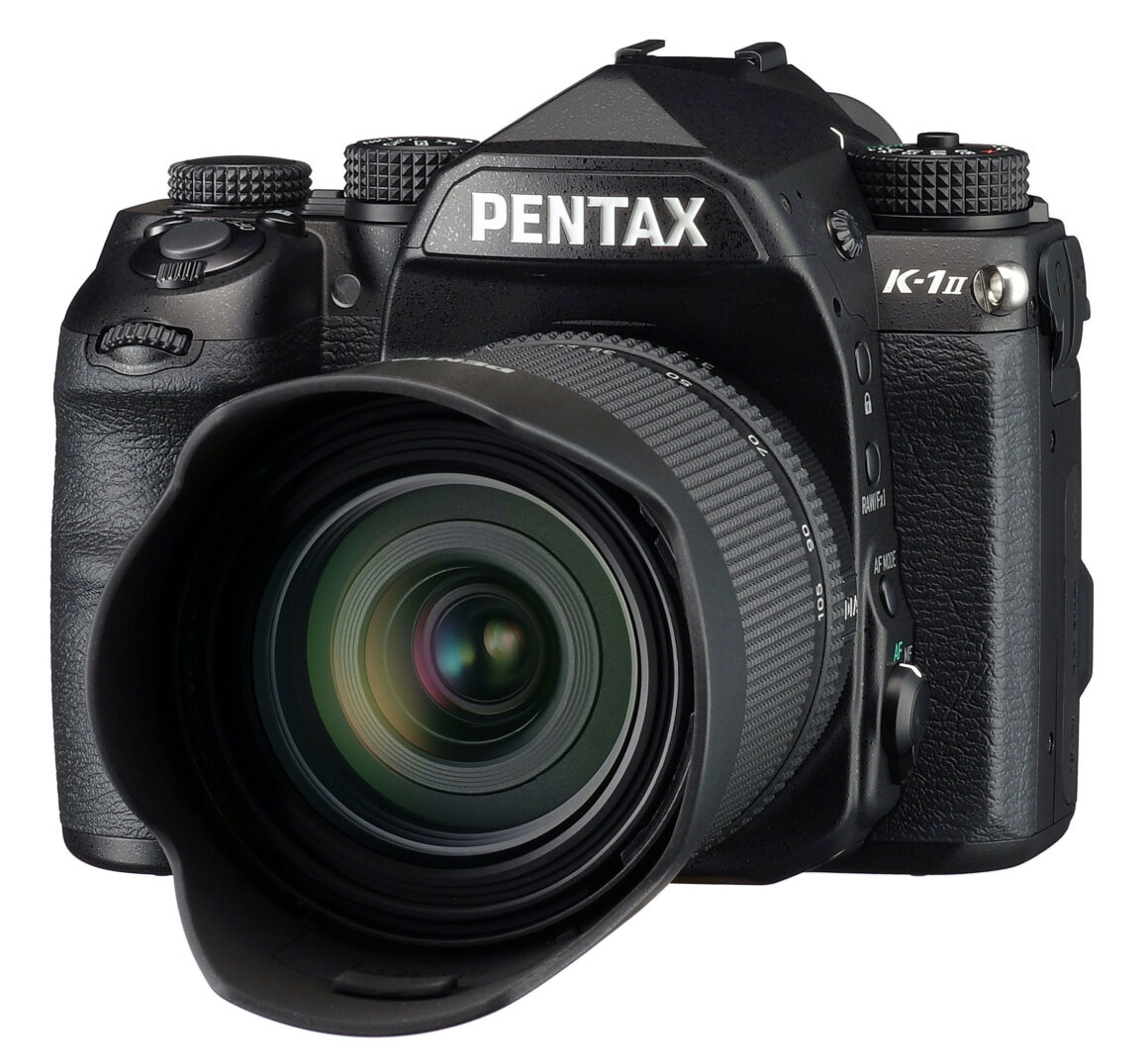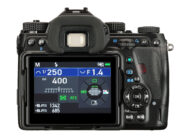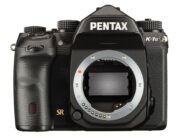Pentax K-1 Mark II
35mm AF digital SLR camera
Specification
| Production details: | |
| Announced: | February 2018 |
| System: | ● Pentax K (1975) |
| Format: | |
| Maximum format: | 35mm full frame |
| Imaging sensor: | 35.9 × 24mm CMOS sensor |
| Resolution: | 7360 × 4912 - 36 MP |
| Sensor-shift image stabilization: | Yes |
| Mount and Flange focal distance: | Pentax K [45.5mm] |
| Shutter: | |
| Type: | Focal-plane |
| Model: | Electronically controlled |
| Speeds: | 30 - 1/8000 + B |
| Exposure: | |
| Exposure metering: | Through-the-lens (TTL), open-aperture |
| Exposure modes: | Programmed Auto |
| Aperture-priority Auto | |
| Shutter-priority Auto | |
| Manual | |
| Physical characteristics: | |
| Weight: | 925g |
| Dimensions: | 136.5x110x85.5mm |
Manufacturer description
WEST CALDWELL, NJ, February 21, 2018-Ricoh Imaging Americas Corporation today announced the PENTAX K-1 Mark II 35mm full-frame digital SLR (DSLR) camera. Developed as the successor to the PENTAX K-1 full-frame DSLR camera launched in April 2016, the compact, rugged and weather-resistant PENTAX K-1 Mark II now becomes the flagship camera in the acclaimed PENTAX K-series lineup. The camera incorporates new technologies that allow it to deliver outstanding image quality and improved operability in a broader range of shooting conditions.
The PENTAX K-1 Mark II uses the same full-frame Anti-aliasing (AA)-filterless CMOS sensor with 36.4 effective megapixels as its predecessor model. However, Ricoh has added a new accelerator unit to the PENTAX K-1 Mark II that—along with the camera’s PRIME IV image processor—enables it to produce high-resolution images with minimal noise in even in the most challenging low-light conditions, up to ISO 819200. This makes the new camera ideal for low-light photography where higher shutter speeds are required.
The camera also incorporates Pixel Shift Resolution System II. This new, PENTAX-developed technology uses the same in-camera shake-reduction (SR) mechanism and sensor-shift capabilities as the original Pixel Shift Resolution System found in the PENTAX K-1, which captures four images of the same scene, and then synthesizes them into a single, super-high-resolution composite image. With the Pixel Shift Resolution System II, the camera also obtains RGB color data, resulting in images with significantly finer details and truer colors than those produced by typical full-frame sensors.
A new feature in the Pixel Shift Resolution System II is Dynamic Pixel Shift Resolution mode. This mode allows photographers to produce crisp, ultra-high pixel shift resolution images without the need of a tripod, extending the camera’s use to a wider variety of subjects and scenes.
The PENTAX K-1 Mark II also comes equipped with many unique features and functions designed to facilitate creativity and ensure operational comfort that have become the hallmark of PENTAX cameras. These include a sturdy magnesium-alloy body with dustproof, weather-resistant construction; an optical viewfinder with a nearly 100-percent field of view for real-time subject confirmation; Astro Tracer, which simplifies the tracing and photographing of celestial bodies by coupling GPS data with the camera's sophisticated SRII mechanism; and a flexible tilt-type LCD monitor to accommodate various shooting angles.
| Pricing and Availability |
The PENTAX K-1 Mark II camera body will be available in April 2018 for a suggested list price of $1,999.95. The camera body plus HD PENTAX-D FA 28-105mm F3.5-5.6 ED DC WR zoom lens will also be available for a suggested list price of $2,399.95. Both can be purchased at www.us.ricoh-imaging.com as well as at Ricoh Imaging-authorized retail outlets throughout North America.
| Main Features |
1. Newly incorporated accelerator unit delivers high-quality images and excellent super-high-sensitivity imaging performance
The PENTAX K-1 Mark II features a 35mm-format full-frame CMOS image sensor with an AA (anti-aliasing) filter–free design to produce high-resolution images with approximately 36.4 effective megapixels. It also features a new accelerator unit, which optimizes the image data obtained by the full-frame image sensor before delivering it to the high-performance PRIME IV imaging engine. As a result, the camera is capable of producing high-quality images with minimal noise, while retaining excellent resolution at all sensitivity levels, from normal to super-high sensitivities. PENTAX has also updated all image-processing parameters to ensure colors are true to life, with special emphasis on deep blues and lively greens. PENTAX has also dramatically improved the camera’s noise-reduction performance at a high-sensitivity range — up to ISO 819200 — to expand creative possibilities in super low-light shooting.
2. Pixel Shift Resolution System II produces super-resolution images and enables handheld shooting
Building upon the original PENTAX-developed Pixel Shift Resolution System — the super-resolution technology that uses the camera’s in-body shake-reduction mechanism to capture four images of the same scene by shifting the image sensor by a single pixel for each image, and then synthesizes them into a single composite image — is the Pixel Shift Resolution System II,* making its debut in the PENTAX K-1 II. This new system obtains RGB color data for each pixel, resulting in super-high-resolution images with finer details and more realistic colors than those produced by cameras with ordinary full-frame sensors. The Motion Correction functions provides ON/OFF switching, which detects moving elements of the continuously captured images to minimize the effect of subject movement during the image synthesizing process.***The new Dynamic Pixel Shift Resolution mode,** which can be used during handheld shooting, works together with the camera’s shake-reduction mechanism, by synthesizing the composite images while detecting the slight fluctuations of the subject’s position during the capture process.
This technology comes from the reverse thinking of pixel shift technology to utilize the minute camera shake itself to product the composite images. Therefore, by detecting the camera shake in three dimensions, the continuously captured four images are analyzed based on the detected camera shake information and combined into a single file to produce one super high resolution image.
3. High-performance five-axis, five-step SR II system
(1) In-body SR mechanism delivers optimal shake-reduction performance with all compatible lenses The PENTAX K-1 Mark II comes equipped with the PENTAX-developed SR II (Shake Reduction II) five-axis mechanism, which provides accurate control of the large full-frame image sensor with all compatible PENTAX interchangeable lenses.* In addition to camera shake caused by pitch and yaw, this advanced system also compensates for camera shake caused by horizontal and vertical shift (often generated in macro photography) and camera shake caused by roll, which is difficult for lens-installed shake-reduction mechanisms to handle. It has a compensation range up to five steps (measured in conformity with CIPA standards, using the HD PENTAX-D FA 28-105mm F3.5-5, 6ED DC WR at a 105mm focal length). When taking a panning shot, this system automatically detects the direction of the camera’s movement, and efficiently controls the SR unit to produce the best image possible without requiring any mode switching operation.
(2) Innovative AA filter simulator to minimize moiré and inaccurate color rendition By applying microscopic vibrations to the image sensor unit at the sub-pixel level during image exposure, the camera’s anti-aliasing (AA) filter simulator** provides the same level of moiré reduction as an optical AA filter. Unlike an optical filter, which always creates the identical result, this innovative simulator not only lets the user switch the AA filter effect on and off, but also adjust the level of the effect. This means that the ideal effect can be set for a particular scene or subject based on given photographic conditions.
(3) Additional shooting functions enabled by the SR II system Since the camera’s SR unit has a flexible design that tilts the image sensor unit in all directions, additional shooting functions are enabled, including auto level compensation, image-composition fine-adjustment, and Astro Tracer, a feature that works along with the built-in GPS, to produce super-sharp images of the night sky.
4. Flexible, tilting LCD monitor facilitates shooting in the dark On its back panel, the PENTAX K-1 Mark II features a flexible, tilting LCD monitor, which can be adjusted to the desired angle horizontally, vertically or diagonally with a single adjustment, without deviating from the lens’s optical axis. The user can not only tilt it approximately 35 degrees horizontally and approximately 44 degrees vertically, but also pull it out from its base to view the on-screen image from above for waist-level photography. This large, 3.2-inch LCD monitor has approximately 1,037,000 dots and a 3:2 aspect ratio, and provides a protective tempered-glass front panel for added durability. In addition to its wide-view design, it also features a unique air-gapless construction, in which the air space between LCD layers is eliminated to effectively reduce the reflection and dispersion of light for improved visibility during outdoor shooting. Its outdoor monitor function, which allows instant adjustment of the monitor’s brightness to the desired level, has also been improved to provide greater visibility in dark locations. Its red-lit monitor display function facilitates monitor viewing when the photographer’s eyes have become accustomed to a dark location during nighttime photography.
5. SAFOX 12 with 33 sensor points and full-frame-proportioned AF frame Using a SAFOX 12 AF sensor module with 33 AF sensors (25 cross-type sensors positioned in the middle), the PENTAX K-1 Mark II optimizes the autofocus process, and assures high-speed autofocus operation in the AF.S (AF Single) mode. The center sensor and two sensors located just above and below it are designed to detect the light flux of an F2.8 lens, making it easy to obtain pinpoint focus on a subject when using a large-aperture lens. Its AF Tracking algorithm has also been revised to improve tracking accuracy of fast-moving subjects in the AF.C (AF Continuous) mode.
6. PENTAX Real-Time Scene-Analysis System, developed using artificial intelligence technology By combining an approximately 86,000-pixel RGB metering sensor with the high-performance PRIME IV imaging engine, the PENTAX K-1 Mark II’s advanced PENTAX Real-Time Scene Analysis System performs real-time analysis of the brightness distribution over the image field and the subject’s colors and movement. Based on this data, it then measures the subject’s lighting conditions with great accuracy and optimizes the exposure. By adopting a breakthrough artificial intelligence technology, deep learning, to its algorithm,* it assesses each individual scene more accurately, and optimizes the exposure settings for a given scene or composition.
7. Easy-to-focus optical viewfinder with nearly 100-percent field of view Optimized for a 35mm full-frame digital SLR design, the camera’s optical viewfinder provides a nearly 100-percent field of view and an approximately 0.7-times magnification. Using a combination of a condenser lens and aspherical lens, it provides a wide field of view and a clear, undistorted image of the subject. It comes with a Natural Bright Matt III focusing screen, acclaimed for ease of focusing during manual-focus operation, and true-to-life rendition of defocused areas in the viewfinder image. In addition, its transparent viewfinder display makes it possible to superimpose a wide range of photographic data over the viewfinder image.
8. High-speed continuous shooting The PENTAX K-1 Mark II allows continuous recording of as many as 17 images in the RAW format (or a maximum of 70 images in the JPEG Best format) in a single sequence, at a top speed of approximately 4.4 images per second. This is made possible by the combination of advanced mechanisms including a damper mechanism that effectively minimizes mirror shock; high-speed, high-precision control of the shutter and mirror units; and a high-speed data transmission system incorporated in the PRIME IV imaging engine. In the APS-C Crop mode, the drive speed can be boosted to as high as approximately 6.4 images per second, and as many as 50 images in a single sequence in the RAW format (or 100 images in the JPEG Best format) to assure quick response to fast-moving subjects.
9. Supportive shooting functions to improve picture-taking efficiency and operational comfort
- Operation-assist light function, which sets LED lights at four different spots around the camera body — above the lens mount, behind the LCD monitor, at the memory car slot, and at the cable switch terminal — to facilitate lens and memory card changes, attachment and removal of the cable switch, and control button operation at night and in poorly lit settings.
- Key lock function, which prevents erroneous operation of the four-way controller and other exposure-related control buttons.
- Smart Function, which allows the user to swiftly choose and set desired functions using just the function dial and the set dial on the camera’s upper panel, without referring to the menu screen on the LCD monitor.
- Control panel customize function, which allows the user to change a listing and/or position of the on-screen menu.
10. Compact, rugged body with dustproof, weather-resistant construction The camera’s bottom panel and front and back frames are all made of sturdy yet lightweight magnesium alloy. Although the camera features a dependable, durable shutter unit that can withstand 300,000 shutter releases (measured under actual shooting conditions) for professional use, its body has been downsized to the minimum possible, thanks to the incorporation of a unique floating mirror structure. With the inclusion of 87 sealing parts in the body, the camera also boasts a dustproof, weather-resistant and cold-resistant construction, assuring solid operation at temperatures as low as -10°C. All these features make the PENTAX K-1 Mark II a dependable, all-purpose performer, even under demanding shooting conditions.
11. Full HD movie recording with an array of creative tools The PENTAX K-1 Mark II captures Full HD movie clips (1920 x 1080 pixels; 60i/30p frame rate) in the H.264 recording format, and comes equipped with a stereo mic terminal for external microphone connection, and a headphone terminal. The user can also adjust the audio recording level manually, monitor sound pressure levels during microphone recording, and cut down wind noise using a new wind-noise reduction mode. In addition to a host of distinctive visual effects for movie recording,* the camera also provides the interval movie mode, which captures a series of 4K-resolution (3840 x 2160 pixels) movie clips at a fixed interval.
12. Built-in GPS module The PENTAX K-1 Mark II provides a variety of advanced GPS functions, including the recording of location, latitude, longitude, altitude and UTC (Universal Time Coordinated) and direction at the time of shooting. The user can easily access images containing GPS data using a computer, to browse them, check on shooting locations and position data on the screen, or save them. The camera also provides a set of other unique tools, including: Electronic Compass, which displays the camera's direction on its LCD monitor; GPS log, which keeps track of the photographer's movement; and Astro Tracer, which simplifies the tracing and photographing of celestial bodies by coupling GPS data with the camera's SR mechanism.
13. Other features
- High-grade DRII (Dust Removal II) mechanism for effective elimination of dust on the image sensor using ultrasonic vibration
- Crop mode with a choice of image area from AUTO, FF (Full Frame), APS-C and 1:1
- Wireless LAN connection to support the operation with smartphones and table computers, the transfer of captured images, and remote shooting operations ・HDR (High Dynamic Range) shooting mode with RAW-format data filing, usable in handheld shooting
- The PENTAX-invented hyper operating system for quick, accurate response to the photographer's creative intentions
- Dual SD card slots for memory card flexibility (compatible with SDXC UHS-1 speed class in SDR104 bus speed mode)
- Compensation of various parameters: lens distortion, lateral chromatic aberration, diffraction, and brightness level at image-field edges. Fringe effect compensation is also available in RAW-format processing.
- Bulb Timer function to improve operability in bulb shooting
- Compatibility with PENTAX Image Transmitter 2 tethering software (software update required from RICOH IMAGING official website)
- Digital Camera Utility 5 software (latest version) included
Special limited editions (2)
- Pentax K-1 Mark II J limited 01 - February 2021
- Pentax K-1 Mark II Silver Edition (1000 units) - August 2020
Table of contents
Clickable
Instruction manual
Clickable
Pentax K system cameras
Clickable
- Asahi Pentax K1000
- Asahi Pentax K1000 SE
- Asahi Pentax K2
- Asahi Pentax K2 DMD
- Asahi Pentax KM
- Asahi Pentax KX
- Asahi Pentax ME
- Asahi Pentax MX
- Pentax *ist
- Pentax A3
- Pentax K-1
- Pentax K-1 Mark II
- Pentax LX
- Pentax ME F
- Pentax ME SE
- Pentax ME super
- Pentax MG
- Pentax MV
- Pentax MV1
- Pentax MZ-10
- Pentax MZ-3
- Pentax MZ-30
- Pentax MZ-5
- Pentax MZ-50
- Pentax MZ-5n
- Pentax MZ-6
- Pentax MZ-60
- Pentax MZ-7
- Pentax MZ-M
- Pentax MZ-S
- Pentax P30
- Pentax P30n
- Pentax P30t
- Pentax P50
- Pentax program A
- Pentax SF7
- Pentax SFX
- Pentax SFXn
- Pentax super A
- Pentax Z-1
- Pentax Z-10
- Pentax Z-1P
- Pentax Z-20
- Pentax Z-5
- Pentax Z-50
- Pentax Z-50P
- Pentax Z-5P
- Pentax Z-70


